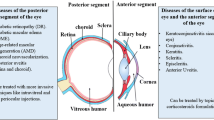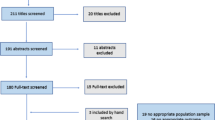Abstract
Background
Although it has been suggested that ergot derivatives may play a role in antiglaucoma therapy, little attention has been paid to the ocular hypotensive action of these drugs. Having previously reported that topical natural ergot alkaloids ergocristine α-ergocryptine and ergocornine dose-dependently reduce intraocular pressure in ocular normotensive and α-chymotrypsin-induced ocular hypertensive rabbits, the aim of the present work was to compare the effect of ergocristine, α-ergocryptine and ergocornine on the intraocular pressure and aqueous humor dynamics in ocular normotensive and α-chymotrypsin-induced ocular hypertensive rabbits, in order to further explore the ocular actions of these compounds.
Methods
Experiments were conducted in albino ocular normotensive and hypertensive rabbits by intracameral injection of α-chymotrypsin. Intraocular pressure responses to drug vehicle and seven different doses of topical natural ergot alkaloids were examined, in order to obtain dose–response relationships for comparing the intraocular pressure-lowering effect and potency of these drugs. Tonographies were also performed to ascertain the actions of natural ergot alkaloids on aqueous humor dynamics.
Results
All natural ergot alkaloids tested reduced intraocular pressure in a dose-related fashion. The ocular hypotensive effect was greater in α-chymotrypsin-induced ocular hypertensive rabbits for the three compounds tested. All natural ergot alkaloids tested decreased both tonographic outflow facility and, to a greater extent, aqueous humor inflow in ocular normotensive and in α-chymotrypsin-induced ocular hypertensive rabbits.
Conclusion
Taken together, our data suggest that these compounds decrease both tonographic outflow facility and, to a greater extent, aqueous humor inflow, which explains their final effect in ocular normotensive and in α-chymotrypsin-induced ocular hypertensive rabbits. Reductions in aqueous humor inflow observed after topical application of natural ergot alkaloids in α-chymotrypsin-induced ocular hypertensive rabbits can only be explained by a marked inhibition of active secretion of aqueous humor, since processes involved in aqueous humor formation may probably be altered after α-chymotrypsin injection.


Similar content being viewed by others
References
Al-Sereiti MR, Quik RF, Turner P (1989) The effect of a single oral dose of pergolide on intraocular pressure and pupil diameter. Br J Clin Pharmacol 28:263–268
Barnett N, Osborne NN (1993) The presence of serotonin (5-HT1) receptors negatively coupled to adenylate cyclase in rabbit and human iris-ciliary processes. Exp Eye Res 57:209–216
Becker B, Constant MA (1956) The facility of aqueous outflow. A comparison of tonography and perfusion measurements in vitro and in vivo. Arch Ophthalmol 55:305–312
Bronner A, Hommura S (1973) Influence de l’hydergine sur l’hydrodynamique de l’humeur aqueuse et sur la circulátion rétinienne. Med Strasbourg J 4:809–816
Coppi G (1992) Dihydroergocristine: a review of pharmacology and toxicology. Arzneimittelforschung 42:1381–1390
Chang FW, Burke JA, Potter DE (1985) Mechanism of the ocular hypotensive action of ketanserin. J Ocul Pharmacol 1:137–147
Chidlow G, Cupido A, Melena J, Osborne NN (2001) Flesinoxan, a 5-HT1A receptor agonist/alpha 1-adrenoceptor antagonist, lowers intraocular pressure in NZW rabbits. Curr Eye Res 23:144–153
Chidlow G, Le Corre S, Osborne, NN (1998) Localization of 5-hydroxytryptamine1A and 5-hydroxytryptamine7 receptors in rabbit ocular and brain tissues. Neuroscience 87:675–689
Chu E, Socci R, Chu TC (2004) PD128,907 induces ocular hypotension in rabbits: involvement of D2/D3 dopamine receptors and brain natriuretic peptide. J Ocul Pharmacol Ther 20:15–23
Chu T, Ogidigben, MJ, Potter, DE (1999) 8-OH-DPAT-induced ocular hypotension: sites and mechanisms of action. Exp Eye Res 6:227–238
Diotavelli M, Auricchio G (1964) The effect of topically used hydergine on ocular tension. Ophthalmologica 147:448–454
Eisenlohr JE, Langham RF (1962) The relationship between pressure and volume changes in living and dead rabbit eyes. Invest Ophthalmol 1:63–67
Elibol O, Guler C, Yuksel N (1992) The effects of dopamine, haloperidol and bromocriptine on intraocular pressure. Int Ophthalmol 16:343–347
Farahbakhsh NA, Cillufo MC (1994) Synergistic effect of adrenergic and muscarinic receptor activation of [ Ca2+] spikes and Ca2+ currents in rabbit ciliary body epithelial cells. Exp Eye Res 58:197–206
Fourman S, Fourman MB (1989) Correlation of tonography and constant pressure perfusion measurements of outflow facility in the rabbit. Curr Eye Res 9:963–969
Genée E, Geisendörfer T (1975) Blutdruckändernde Medikamente und Augeninnendruck im Tierversuch. Albrecht v Graefes Klin Exp Ophthal 95:187–194
Green K (1992) Models and methods for testing toxicity of aqueous humor, iris and ciliary body. In: Hockwin O, Green K, Rubin L (eds) Manual of oculotoxicity testing of drugs. Gustav Fischer, Stuttgart, pp 219–242
Hochgesand DH, Dunn JJ, Crook RB (2001) Catecholaminergic regulation of Na-K-Cl cotransport in pigmented ciliary epithelium: differences between PE and NPE. Exp Eye Res 72:1–12
Krootila K, Palkama A, Uusitalo H (1987) Effect of serotonin and its antagonist (ketanserin) on intraocular pressure in the rabbit. Ocul Pharmacol J 4:279–290
Mancino R, Cerulli L, Ricci A, Amenta F (1992) Direct demonstration of dopamine D1-like receptor sites in the ciliary body of the rabbit eye by light microscope autoradiography. Naunyn Schmiedebergs Arch Pharmacol 346:644–648
Melena J, Santafé J, Segarra-Doménech J, Puras G (1999) Aqueous humor dynamics in alfa chymotrypsin-induced ocular hypertensive rabbits. J Ocul Pharmacol Ther 15:19–26
Melena J, Santafé J, Segarra-Doménech J (1998) The effect of topical dihydroergocristine on the intraocular pressure in chymotrypsin-induced ocular hypertensive rabbits. Meth Find Exp Clin Pharmacol 20:861–867
Mito T, Delamere NA, Coca-Prados M (1993) Calcium-dependent regulation of cation transport in cultured human nonpigmented ciliary epithelial cells. Am J Physiol 33:519–525
Neufeld AH, Page ED (1977) In vitro determination of the ability of drugs to bind to adrenergic receptors. Invest Ophthalmol Vis Sci 16:1118–1124
Ohuchi T, Yoshimura N, Tanihara H, Kuriyama S, Ito S, Honda Y (1992) Ca2+ mobilization in nontransformed ciliary nonpigmented epithelial cells. Invest Ophtalmol Vis Sci 33:1696–1705
Osborne NN, Wood JP, Melena J, Chao HM, Nash MS, Bron AJ, Chidlow G (2000) 5-Hydroxytryptamine1A agonists: potential use in glaucoma. Evidence from animal studies. Eye 14:454–463
Peroutka SJ (1996) Drugs effective in the therapy of migraine. In: Hambard JG, Limbird LE (eds) Goodman & Gilman’s the pharmacological basis of therapeutics, 9th edn. McGraw Hill, New York, pp 487–502
Potter DE (1981) Adrenergic pharmacology of aqueous humor dynamics. Pharmacol Rev 33:133–153
Potter DE, Ogidigben MJ, Chu TC (1998) Lisuride acts at multiple sites to induce ocular hypotension and mydriasis. Pharmacology 57:249–260
Potter DE, Shumate DJ (1987) Cianergoline lowers intraocular pressure in rabbits and monkeys and inhibits contraction of the cat nictitans by suppressing sympathetic neuronal function. J Ocul Pharmacol 3:309–321
Potter DE, Burke JA (1982) Effects of ergoline derivatives on intraocular pressure and iris function in rabbits an monkeys. Curr Eye Res 2:281–288
Prunte C, Nuttli I, Markstein R, Kohler C (1997) Effects of dopamine D-1 and D-2 receptors on intraocular pressure in conscious rabbits. J Neural Transm 104:111–123
Puras G, Santafé J, Segarra, J, Melena J (2002) Effects of topical natural ergot alkaloids on intraocular pressure and aqueous humor dynamics in ocular normotensive rabbits. J Ocul Pharmacol Ther 18:41–52
Puras G, Santafe J, Segarra J, Garrido M, Melena J (2002) The effect of topical natural ergot alkaloids on the intraocular pressure and aqueous humor dynamics in rabbits with alpha-chymotrypsin-induced ocular hypertension. Graefes Arch Clin Exp Ophthalmol 240:322–328
Quigley HA, Broman AT (2006) The number of people with glaucoma worldwide in 2010 and 2020. Br J Ophthalmol 90:262–267
Rintelen F, Smolik H (1950) Über den Einfluss des Hydergins auf den intraokularen and diastolischen Zentralarteriendruck. Ophthalmologica 120:100–103
Roquebert J, Demichel P (1987) Agonist/antagonist activity of ergocristine at alpha-adrenoceptors in the rat. Fundam Clin Pharmacol 1:23–33
Rowell PP, Larson BT (1999) Ergocryptine and other ergot alkaloids stimulate the release of [3H]dopamine from rat striatal synaptosomes. J Anim Sci 77:1800–1806
Rowland JM, Potter DE, Reiter RJ (1981) Circadian rhythm in intraocular pressure: a rabbit model. Curr Eye Res 1:169–173
Santafé J, Segarra J, Garrido M, Pablo V (1991) Effects of topical dihydroergocristine on intraocular pressure, aqueous humor dynamics and pupil diameter in conscious rabbits. A comparative study with timolol and pilocarpine. Meth Find Exp Clin Pharmacol 13:231–238
Savolainen J, Rautio J, Razzetti R, Jarvinen T (2003) A novel D2-dopaminergic and alpha2-adrenoceptor receptor agonist induces substantial and prolonged IOP decrease in normotensive rabbits. J Pharm Pharmacol 55:789–794
Siegel MJ, Lee PY, Podos SM, Mittag TW (1987) Effect of topical ergolide on aqueous dynamics in normal and glaucomatous monkeys. Exp Eye Res 44:227–233
Simkova M, Zahn K (1952) The effect of hydergine on retinal circulation. Ophthalmologica 124:39–49
Steinbach PD, Bell H (1977) Wirkung gefäserweiternder Substanzen auf Augeninnendruck und Blutdruck. Albrecht v Graefes Arch Klin Exp Ophthal 202:213–222
Sugrue MF (1997) New approaches to antiglaucoma therapy. J Med Chem 40(18):2793–2809
Acknowledgements
This research work has been carried out with funds from the Universidad del País Vasco (Spain). G. Puras and J. Melena were supported by fellowships from the Universidad del País Vasco and the Gobierno Vasco (Spain) respectively.
Author information
Authors and Affiliations
Corresponding author
Rights and permissions
About this article
Cite this article
Puras, G., Santafé, J., Segarra, J. et al. A comparative study of topical natural ergot alkaloids on the intraocular pressure and aqueous humor dynamics in oclular normotensive and α-chymotrypsin-induced ocular hypertensive rabbits. Graefes Arch Clin Exp Ophthalmol 245, 1559–1567 (2007). https://doi.org/10.1007/s00417-007-0596-3
Received:
Revised:
Accepted:
Published:
Issue Date:
DOI: https://doi.org/10.1007/s00417-007-0596-3




